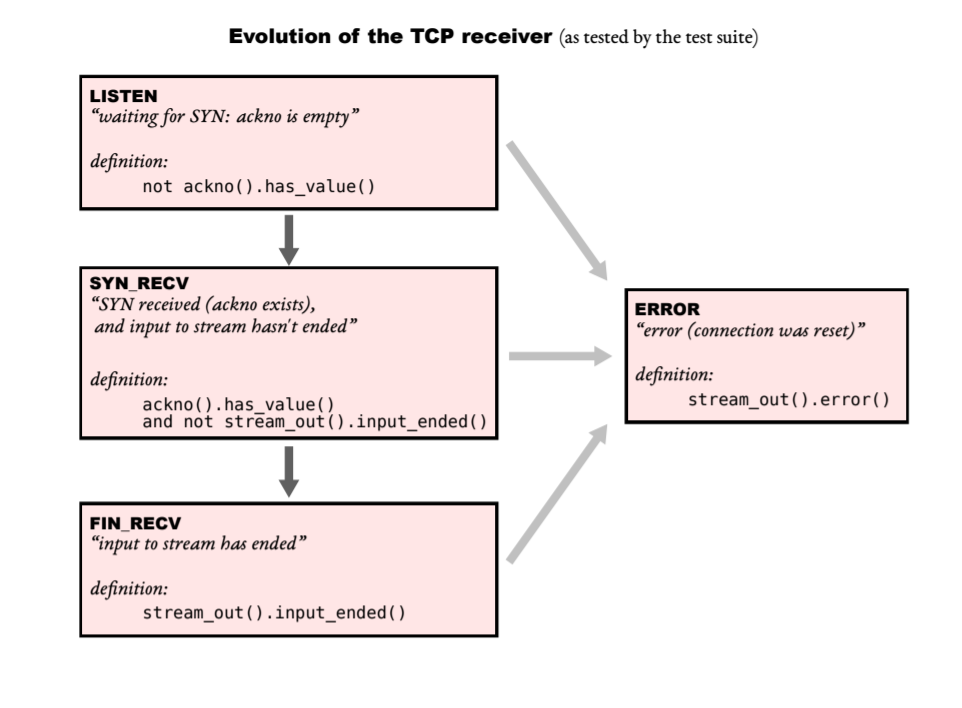CS144-Lab2
实验架构

除了写入传入流之外,TCPReceiver 还负责通知 sender 两件事:
- “
First unassembled” 字节的索引,称为“acknowledgment”或 “ackno”。这是接收方需要来自发送方的第一个字节。 - “
first unassembled” 索引和“first unacceptable”索引之间的距离。这称为“window size”。
总的来说,ackno 和 window size 述了 TCPreceiver 的窗口:TCPsender 被允许发送一系列索引。使用该窗口,TCPreceiver 可以做到流量控制,使发送方限制它发送的数量,直到接收方准备好更多的数据。有时,我们将 ackno 称为窗口的“左边”( TCPRecsigner 的最小索引),而 ackno + window size 则称为“右边缘”(略大于 TCPReceiver 的最大索引)。
在编写 Stream Reassembler 和 Byte Stream 时,您已经完成了实现 TCP Receiver 所涉及的大部分算法工作;本实验是将这些通用类连接到 TCP 的细节。最困难的部分将涉及考虑 TCP 将如何表示每个字节在流中的位置——称为“sequence number”。
我们将要实现的 TCPReceiver 需要完成的功能:
- 接收
TCP segment - 重新组装
ByteStream - 发送
ackno和window size回TCP sender,以进行流量控制和数据确认
环境配置
当前我们的实验代码位于 master 分支,而在完成 Lab 之前需要合并一些依赖代码,因此执行以下命令:
1 | git merge origin/lab2-startercode |
之后重新 make 编译即可。
The TCP Receiver
在 Lab2,我们将实现一个 TCPReceiver,用以接收传入的 TCP segment 并将其转换成用户可读的数据流。
TCPReceiver 除了将读入的数据写入至 ByteStream 中以外,它还需要告诉发送者两个属性:
- 第一个未组装的字节索引,称为确认号ackno,它是接收者需要的第一个字节的索引。
- 第一个未组装的字节索引和第一个不可接受的字节索引之间的距离,称为 窗口长度window size。
ackno 和 window size 共同描述了接收者当前的接收窗口。接收窗口是 发送者允许发送数据的一个范围,通常 TCP 接收方使用接收窗口来进行流量控制,限制发送方发送数据。
总的来说,我们将要实现的 TCPReceiver 需要做以下几件事情:
- 接收TCP segment
- 重新组装字节流(包括EOF)
- 确定应该发回给发送者的信号,以进行数据确认和流量控制
1. Translating between 64-bit indexes and 32-bit seqnos
作为热身,我们需要实现TCP表示索引的方式。上周您创建了一个StreamReassembler,它重组子字符串,其中每个字节都有一个64位流索引,流中的第一个字节总是索引为0。64位索引足够大,我们可以将其视为永不溢出。然而,在TCP报头中,空间是宝贵的,流中的每个字节的索引不是用64位的索引表示的,而是用32位的“序列号”或“seqno”表示的。这增加了三个复杂性:
- 您的实现需要为32位整数进行规划:TCP中的流可以是任意长的——对于可以通过TCP发送的字节流的长度没有限制。但是232字节只有4GiB,并不是很大。一旦一个32位的序列号计数到232−1,流中的下一个字节的序列号将为0。
- TCP序列号从一个随机值开始:为了提高安全性,并避免被属于同一端点之间早期连接的旧段所混淆,TCP试图确保序列号不会被猜测,并且不太可能重复。所以流的序列号不是从0开始的。流中的第一个序列号是一个随机的32位数字,称为初始序列号(Initial sequence number, ISN)。这是表示SYN(流的开始)的序列号。其余的序列号在此之后正常运行:数据的第一个字节将有ISN+1 (mod 232)的序列号,第二个字节将有ISN+2 (mod 232),等等。
- 每个逻辑开始和结束占用一个序列号:除了确保接收到所有字节的数据外,TCP还确保可靠地接收流的开始和结束。因此,在TCP中SYN (start -ofstream)和FIN (end- stream)控制标志被分配了序列号。每一个都占用一个序列号。(SYN标志占用的序列号是ISN。)流中的每个数据字节也占用一个序列号。请记住,SYN和FIN不是流本身的一部分,也不是“字节”——它们表示字节流本身的开始和结束。

1 |
|
这段代码定义了一个名为WrappingInt32的类,表示相对于一个任意初始序列号(ISN)的32位整数。它被用来表示TCP序列号(seqno)和确认号(ackno)。此外,还定义了一些帮助函数,用于转换绝对序列号和相对序列号之间的关系。
具体来说,这里的WrappingInt32类只有一个私有成员变量_raw_value,它表示一个32位无符号整数的原始值。类中定义了一个公有构造函数explicit WrappingInt32(uint32_t raw_value),用于将一个无符号整数转换为WrappingInt32对象。类还提供了一个公有成员函数uint32_t raw_value() const,用于访问对象的原始值。
此外,还定义了两个函数wrap和unwrap,分别用于将绝对序列号转换为相对序列号,以及将相对序列号转换为绝对序列号。wrap函数的输入参数为一个64位无符号整数n和一个WrappingInt32对象isn,输出为一个WrappingInt32对象,表示n相对于isn的相对序列号。unwrap函数的输入参数为一个WrappingInt32对象n,一个WrappingInt32对象isn,以及一个64位无符号整数checkpoint,输出为一个64位无符号整数,表示最接近checkpoint并相对于isn的序列号值为n的绝对序列号。
最后,还定义了一些辅助函数,如operator-,用于计算两个WrappingInt32对象之间的差值,operator==和operator!=用于比较两个WrappingInt32对象是否相等,operator<<用于将一个WrappingInt32对象输出到流中,以及operator+和operator-,分别用于将一个WrappingInt32对象向前或向后移动一定的距离。
1 |
|
这段代码包含了两个函数的实现,一个是 wrap,另一个是 unwrap。
wrap 函数将一个 64 位的绝对序列号转换为一个 32 位的相对序列号,以 isn 为初始序列号。
unwrap 函数将一个 32 位的相对序列号转换为一个 64 位的绝对序列号,以 isn 为初始序列号,并指定一个最近的绝对序列号 checkpoint,函数的返回值是一个绝对序列号,它等于相对序列号 n 对应的绝对序列号,同时又尽可能接近于 checkpoint。
其中 wrap 函数的实现比较简单,直接将输入的绝对序列号 n 加上初始序列号 isn,得到一个相对序列号即可。
而 unwrap 函数的实现稍微复杂一些。首先计算 n 和 checkpoint 之间的偏移量 offset,即 n 对应的绝对序列号与 checkpoint 的绝对序列号之差。然后将 offset 加到 checkpoint 上,就得到了 n 对应的绝对序列号 res。
这里需要注意一个问题,当 offset 的值比较大时(即大于等于 0x80000000),此时 n 对应的序列号可能要“绕一圈”,从而超过了 32 位的表示范围。因此,如果 res 大于等于 0x100000000,则需要减去 0x100000000,即从头开始计数,避免超出 32 位的表示范围。
Implementing the TCP receiver
1 |
|
TCPReceiver 的解释如下:
TCP 接收器用于接收和重新组装 TCP Segment,并计算确认号和窗口大小以返回给远程发送器。
主要成员变量和函数包括:
StreamReassembler _reassembler:用于重新组装字节的数据结构;size_t _capacity:TCP 接收器可以同时存储的最大字节数;std::optional<WrappingInt32> _ackno{}:应该发送到对等端的ackno,如果没有接收到SYN则为空;WrappingInt32 _isn{0}:初始序列号(ISN);WrappingInt32 _seq{0}:接收到的最后一个 TCP 分段的序列号;uint64_t _checkpt{0}:最后一个重新组装的字节的索引(绝对序列号);ackno():返回应该发送到对等端的 ackno,如果没有接收到SYN则为空;window_size():返回应该发送到对等端的窗口大小;unassembled_bytes():返回已存储但尚未重新组装的字节数;segment_received():处理传入的 TCP 分段。
该类的主要功能是:
- 接收传入的 TCP 分段,并将其发送到
StreamReassembler进行重新组装; - 计算应该发送给远程
TCPSender的ackno和窗口大小,以便TCPSender知道还有多少可用的空间; - 提供
stream_out()函数,用于读取已重新组装的数据。
TCP receiver 在连接生命周期中的状态转移

1 |
|
这段代码实现了TCP接收端的主要逻辑,即处理TCP段并将它们重新组装成字节流。代码中有几个状态,分别对应TCP协议中的连接建立、连接终止和正常数据传输的不同阶段。
首先,如果接收端还没有收到 SYN,就判断接收到的 TCP 段是否是 SYN,如果是,则在随机生成一个初始序列号后,将接收到的数据传递给 StreamReassembler 进行重新组装,并更新需要发送给发送方的确认序列号 _ackno。如果还没有收到 SYN,则直接返回。
如果接收端已经收到了 SYN,但还没有收到 FIN,则在接收到的TCP段中查找相对于已经接收的字节数偏移量,并使用 StreamReassembler 对接收到的数据进行重新组装。在重新组装之后,需要更新确认序列号 _ackno,并且如果数据流已经结束,需要将确认序列号加一。如果接收到的数据已经过期或已经在之前的数据段中处理过,则不需要重新组装数据,直接返回即可。
如果接收端已经收到了FIN,则不再接受更多的数据,并将 _ackno 加 1 以告诉发送端已经收到了所有数据。